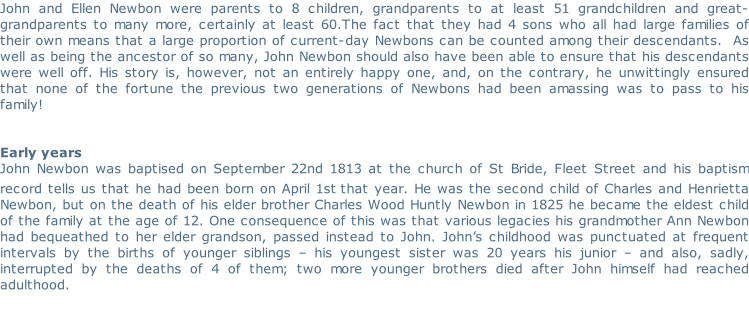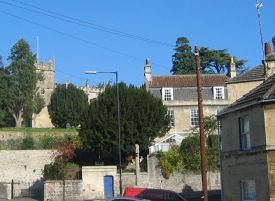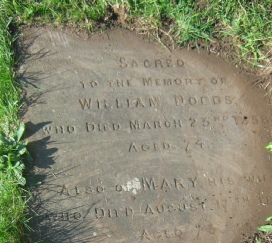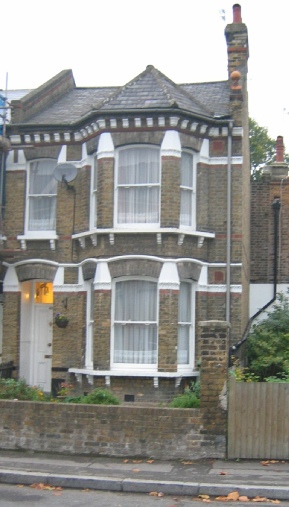

Professional life: a debtor’s story
John Newbon chose the same profession as his father Charles, that of a tailor. Charles had had a very successful business in the City of London, advertisements for which can be found in various trade directories. Indeed, Charles’s business was so successful that on his death in 1859 he left an estate valued at £1500 and was described in his will as a ‘gentleman’. The same document reveals that Charles left his business and all his estate, after the death of his wife Henrietta, to his second son, John’s younger brother Walter Henry (also a tailor); indeed, Charles left nothing at all to John in his will, although a legacy was left to John’s wife Ellen. The reason for Charles overlooking his son is one of the less happy episodes in the Newbons’ history, which was reported in the London and even in the national press. The London Gazette of 1845 contains the following:
The full story can be pieced together from a number of documents found in The National Archives. It reads roughly as follows:
|
|
John Newbon and Ellen Dodds most likely met some time in the early-
|
|
|
At some point in the early-
|
|
|
John Newbon was brought to trial on February 11th 1845, the account of which found in The London Gazette is printed above. John’s sentences ran concurrently from December 21st 1844 (2 days after his imprisonment), and he was released on August 20th 1845.
|
|
|
The day after his release, John’s wife Ellen gave birth to the couple’s 5th child, Charles Henry Newbon.
|
This must have been an emotional time in the Newbon household, but any notion that John might have been allowed home early for the birth of his son is merely a romantic fiction, since John served his 8-
John’s father Charles Newbon must have been shocked, if not appalled, at his son’s predicament. He by no means cut his ties with John’s family as a result, however, but it is interesting that neither did he bale his son out of trouble financially. Charles was certainly a man of means and at some point during the mid-
The Newbon family in Lambeth and Southwark
The addresses for John given in the newspaper reports of 1845 (‘late of no.34 Commercial Road, Lambeth, Surrey[,] previously of no.12 Basing Lane, Bread Street, London and formerly of no.41 Sutton Street, York Road, Lambeth’) give an interesting glimpse of the family’s mobility in the early-
Charles Henry Newbon, whose birth as already mentioned coincided with John’s release in 1845, was born at 23 Vine Terrace, south of the Waterloo area in the parish of St Mary, Lambeth. The family is to found there again on the census of 1851, the year of the Great Exhibition at the Crystal Palace, by which time the scandal would hopefully have blown over. The Newbons are listed at this address along with 2 other families. It is certainly worthy of note that they stayed at the same address for at least 6 years after John’s imprisonment, suggesting a period of much greater stability. John is described in 1851 as a ‘tailor master’, possibly indicating that by this time he was the head of a sizeable business with at least one apprentice. It may well be that he was being economical with the truth, however, or at least thinking what might have been! The fact that his living conditions must have been cramped suggests that he was certainly not well off, but his business may have settled down somewhat by this stage. In 1861, the year that saw the start of the American Civil War, the family were living on their own at 2a Ewhurst Street, Newington, again further south and also further east, and so the family finances may well have been more comfortable by this point.


John Newbon's first wife, Ellen Dodds



where John Newbon died in 1882
By 1871 only John (then in his late 50s) and his 19-
Unfortunately John and Ellen no.2 only enjoyed 3 years of married life together, before Ellen’s death in 1874 (at the age of only 44) left John Newbon a widower for a second time. John himself died on May 4th 1882, at what was presumably his home at the time, 49 Merrow Street, Walworth. The cause of his death was given as ‘apoplexia [of] 6 days’, which probably means a stroke; he was aged 69. His death was registered by his daughter-
John and Ellen Newbon’s children
It is well worth examining the Christian names John and Ellen Newbon chose for their children, since they shed interesting light on the relations between various members of the Newbon family:
|
|
Ellen, the eldest daughter, was clearly named after her mother.
|
|
|
Jessie is the only one of John and Ellen’s children whose name seems to have no connection with any other member of the family.
|
|
|
Henrietta Ann, the 3rd daughter, took as her forename the name of both John's mother and one of his sisters, with Ann being the name of John's grandmother, who had made various legacies to him when she died in 1829.
|
|
|
John Joseph clearly took his first name from his father. Although Charles and Henrietta had a son Joseph, he had died young; the only other Joseph in the family was the son of John’s wealthy cousin James Shelton Newbon, who had been born two years previously; it is not impossible that the two families remained in contact at this time, before John’s imprisonment, but unlikely they did so afterwards.
|
|
|
Charles Henry was born the day after John’s scheduled release from prison and the two Christian names he was given were quite possibly an attempt to build bridges and to bring the family back closer together. Most importantly, Charles was, of course, John's wealthy father, while Henry was the middle name of John's younger brother Walter, who would be the major beneficiary of Charles's will several years later.
|
|
|
Diana Nancy was named after John's younger sister, perhaps a favourite sibling?
|
|
|
Walter Augustus was given the most common of all Christian names in the Newbon family, that of John’s grandfather, as his forename, although Augustus has no obvious family connection.
|
|
|
Thomas Car(e)y Newbon’s forename is not a common name in the Newbon family. Although it was the Christian name of another of James Shelton Newbon’s sons, it seems highly unlikely that these two families would have been at all close at this point in time. Ellen Newbon did have a brother Thomas, however, although it is not known whether or not they remained in contact. Thomas Cary Newbon’s unusual middle name was the maiden surname of his maternal grandmother, Ellen’s mother Mary; it is interesting that Thomas was named not Thomas William after Ellen's father but, more intriguingly, Thomas Cary. Little is known of Ellen’s parents and so it is merely conjecture that there may have been a specific reason for a tribute being appropriate at this time, and indeed, it is not known how close the Newbon family was to William and Mary Dodds, since the latter are only known to have lived in Somerset. Is it possible, though, that John and Ellen were hoping to strengthen relations with Ellen’s parents as the latter entered their 70s? If so, it proved unsuccessful -
|
The above goes to prove that John and Ellen maintained strong links with their family both before John’s imprisonment and afterwards, reinforcing the view that they did remain on good terms with John’s father Charles Newbon until the end of his life, despite the terms of Charles’s will.
It is also likely that John and Ellen’s children remained close to each other throughout their lives. Most of them lived within close proximity and it is interesting to note the regular recurrence of various Christian names among their children. The lives of John and Ellen Newbon’s children are dealt with in detail on a separate page.
On the census
|
Born: |
April 1st 1813 (St Bride’s, Fleet Street) |
Died: |
May 2nd 1882 (Walworth) |
|
Father: |
Charles Newbon (1784- |
Mother: |
Henrietta Newbon, formerly Blyde (c.1790- |
|
Spouses: |
1. Ellen Dodds (1813- 2. Ellen Thorn, formerly Arlett (c.1830- |
Occupation: |
Tailor |
|
Children: |
Ellen Newbon (b.1836), Jessie Newbon (b.1838), Henrietta Ann Newbon (b.1840), John
Joseph Newbon (1842- Charles Henry Newbon (1845- Thomas Cary Newbon (1852- |
||
Insolvent Debtors Court – February 11th
In re[spect of] John Newbon
This insolvent was opposed by Mr Woodruffe, on behalf of Messrs Stebbings, and by a creditor in person.
The complaints of both creditors were of a similar description, viz. – contracting their debts without any reasonable expectation of payment. This insolvent (a tailor) had dealt with the opposing creditors (woolendrapers) and to one of them had represented himself as only indebted to one person, whereas, in point of fact, he was considerably involved.
The CHIEF COMMISSIONER remanded the insolvent for eight calendar months at the suit of Messrs Stebbings and for six months at the suit of Mr Whistler, for contracting debts without the slightest chance of payment.
The Court for the Relief of Insolvent Debtors
The following prisoners, whose estates and effects have been vested in the Provisional
Assignee by order of the Court, having filed their schedules, are ordered to be brought
up before the court at the Court House in Portugal Street, Lincoln’s-
John Newbon, late of no.34 Commercial Road, Lambeth, Surrey previously of no.12 Basing Lane, Bread Street, London and formerly of no.41 Sutton Street, York Road, Lambeth, Surrey, tailor.
To Top of Page
|
1841 |
- |
at home at Sutton Street, Lambeth with his wife Ellen, their 3 eldest daughters and also what looks like a domestic servant. John’s profession is given as ‘tailor & draper’. The probable presence of a servant would suggest that John is trying to live the lifestyle his father and grandfather had been used to, which was clearly unrealistic. |
|
1851 |
- |
at home at 23 Vine Terrace, Lambeth with Ellen and their children. Two other families were living at same address. His profession is given as ‘tailor master’, which may be accurate or it may hark back to the scale of John’s business before his financial difficulties. |
|
1861 |
- |
at home at 2a Ewhurst Street, Newington with Ellen, his daughter Jessie and his 4 sons. This remained the family home for a number of years. |
|
1871 |
|
at 2 Ewhurst Street, Newington with his son Thomas Cary Newbon and the family of his daughter Jessie Shilling. Ellen had died two years previously; John was to marry his 2nd wife just 3 months after the date of this census. |
|
1881 |
- |
at his final home, 49 Merrow Street, Walworth, with his 15- |
| Site Map |
| Background to my research |
| Background to the surname NEWBON |
| Documents available and sources used |
| Name index |
| Walter Newbon's descendants |
| Northamptonshire Newbons |
| Redbourn, Hertfordshire |
| James Shelton Newbon |
| Henry Newbon |
| The Crickmer family |
| The Newbon Family and the City of London |
| Charles Evans Newbon |
| Joseph Newbon |
| The Brockelbank Family |
| The United Wards' Club of the City of London |
| John Newbon |
| The Children of John Newbon |
| World War I |
| Walter Thomas Newbon |
| The Newbon Family of Northamptonshire |
| Northamptonshire, the early home of the Newbon Family |
| King's Cliffe |
| Records of King's Cliffe |
| Maps of King's Cliffe |
| Links with elsewhere |
| News 2014 |
| News 2013 |
| News 2012 |
| News 2011 |
| News 2010 |
| News 2009 |
| News 2008 |
| Updates |
| To do |
| Guestbook |